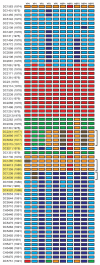Intra-genotypic diversity of archival G4P[8] human rotaviruses from Washington, DC
- PMID: 21712102
- PMCID: PMC3383043
- DOI: 10.1016/j.meegid.2011.05.023
Intra-genotypic diversity of archival G4P[8] human rotaviruses from Washington, DC
Abstract
Group A human rotaviruses (RVs) remain the most frequently detected viral agents associated with acute gastroenteritis in infants and young children. Despite their medical importance, relatively few complete genome sequences have been determined for commonly circulating G/P-type strains (i.e., G1P[8], G2P[4], G3P[8], G4P[8], and G9P[8]). In the current study, we sequenced the genomes of 11 G4P[8] isolates from stool specimens that were collected in Washington, DC during the years of 1974-1991. We found that the VP7-VP4-VP6-VP1-VP2-VP3-NSP1-NSP2-NSP3-NSP4-NSP5/6-encoding genes of all 11 G4P[8] RVs have the genotypes of G4-P[8]-I1-R1-C1-M1-A1-N1-T1-E1-H1. By constructing phylogenetic trees for each gene, extensive intra-genotypic diversity was revealed among the G4P[8] RVs, and new sub-genotype gene alleles were identified. Several of these alleles are nearly identical to those of G3P[8] isolates previously sequenced from this same Washington, DC collection, strongly suggesting that the RVs underwent gene reassortment. On the other hand, we observed that some G4P[8] RVs exhibit completely different allele-based genome constellations, despite being collected during the same epidemic season; there was no evidence of gene reassortment between these strains. This observation extends our previous findings and supports the notion that stable, genetically-distinct clades of human RVs with the same G/P-type can co-circulate in a community. Interestingly, the sub-genotype gene alleles found in some of the DC RVs share a close evolutionary relationship with genes of more contemporary human strains. Thus, archival human RVs sequenced in this study might represent evolutionary precursors to modern-day strains.
Published by Elsevier B.V.
Figures





Similar articles
-
Diversity and relationships of cocirculating modern human rotaviruses revealed using large-scale comparative genomics.J Virol. 2012 Sep;86(17):9148-62. doi: 10.1128/JVI.01105-12. Epub 2012 Jun 13. J Virol. 2012. PMID: 22696651 Free PMC article.
-
Molecular epidemiology of contemporary G2P[4] human rotaviruses cocirculating in a single U.S. community: footprints of a globally transitioning genotype.J Virol. 2014 Apr;88(7):3789-801. doi: 10.1128/JVI.03516-13. Epub 2014 Jan 15. J Virol. 2014. PMID: 24429371 Free PMC article.
-
Complete genome characterization of recent and ancient Belgian pig group A rotaviruses and assessment of their evolutionary relationship with human rotaviruses.J Virol. 2015 Jan 15;89(2):1043-57. doi: 10.1128/JVI.02513-14. Epub 2014 Nov 5. J Virol. 2015. PMID: 25378486 Free PMC article.
-
Reassortment of Human and Animal Rotavirus Gene Segments in Emerging DS-1-Like G1P[8] Rotavirus Strains.PLoS One. 2016 Feb 4;11(2):e0148416. doi: 10.1371/journal.pone.0148416. eCollection 2016. PLoS One. 2016. PMID: 26845439 Free PMC article.
-
Rotavirus diversity and evolution in the post-vaccine world.Discov Med. 2012 Jan;13(68):85-97. Discov Med. 2012. PMID: 22284787 Free PMC article. Review.
Cited by
-
Diversity and relationships of cocirculating modern human rotaviruses revealed using large-scale comparative genomics.J Virol. 2012 Sep;86(17):9148-62. doi: 10.1128/JVI.01105-12. Epub 2012 Jun 13. J Virol. 2012. PMID: 22696651 Free PMC article.
-
Whole genomic analysis of G2P[4] human Rotaviruses in Mymensingh, north-central Bangladesh.Heliyon. 2016 Oct 1;2(9):e00168. doi: 10.1016/j.heliyon.2016.e00168. eCollection 2016 Sep. Heliyon. 2016. PMID: 27722206 Free PMC article.
-
Absence of genetic differences among G10P[11] rotaviruses associated with asymptomatic and symptomatic neonatal infections in Vellore, India.J Virol. 2014 Aug;88(16):9060-71. doi: 10.1128/JVI.01417-14. Epub 2014 Jun 4. J Virol. 2014. PMID: 24899175 Free PMC article.
-
Comparative genomic analysis of genogroup 1 (Wa-like) rotaviruses circulating in the USA, 2006-2009.Infect Genet Evol. 2014 Dec;28:513-23. doi: 10.1016/j.meegid.2014.09.021. Epub 2014 Oct 6. Infect Genet Evol. 2014. PMID: 25301114 Free PMC article.
-
Did Large-Scale Vaccination Drive Changes in the Circulating Rotavirus Population in Belgium?Sci Rep. 2015 Dec 21;5:18585. doi: 10.1038/srep18585. Sci Rep. 2015. PMID: 26687288 Free PMC article.
References
-
- Almanza L, Arias C, Lopez S. Amino acid sequence of the porcine rotavirus YM VP1 protein. Res. Virol. 1994;145(5):313–317. - PubMed
-
- Arora R, Chitambar SD. Full genomic analysis of Indian G1P[8] rotavirus strains. Infect. Gen. Evol. 2011;11:504–511. - PubMed
-
- Desselberger U, Iturriza-Gómara M, Gray JJ. Rotavirus epidemiology and surveillance. Novartis Found. Symp. 2001;238:125–47. - PubMed
Publication types
MeSH terms
Substances
Associated data
- Actions
Grants and funding
LinkOut - more resources
Full Text Sources
Medical

